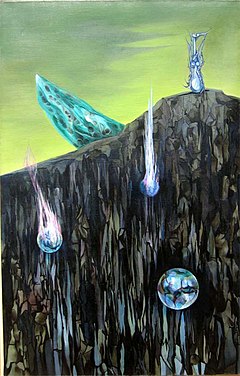
A matriarchal religion is a religion that emphasizes a goddess or multiple goddesses as central figures of worship and spiritual authority. The term is most often used to refer to theories of prehistoric matriarchal religions that were proposed by scholars such as Johann Jakob Bachofen, Jane Ellen Harrison, and Marija Gimbutas, and later popularized by second-wave feminism. These scholars speculated that early human societies may have been organized around female deities and matrilineal social structures. In the 20th century, a movement to revive these practices resulted in the Goddess movement.
History
See also: Matriarchy § By chronologyThe concept of a prehistoric matriarchy was introduced in 1861 when Johann Jakob Bachofen published Mother Right: An Investigation of the Religious and Juridical Character of Matriarchy in the Ancient World. He postulated that the historical patriarchates were a comparatively recent development, having replaced an earlier state of primeval matriarchy, and postulated a "chthonic-maternal" prehistoric religion. Bachofen presents a model where matriarchal society and chthonic mystery cults are the second of four stages of the historical development of religion. The first stage, he called "Hetaerism," was characterized as a paleolithic hunter-and-gatherer society that practiced a polyamorous and communistic lifestyle. The second stage is the Neolithic, a matriarchal lunar stage of agriculture with an early form of Demeter, the dominant deity. This was followed by a "Dionysian" stage of emerging patriarchy, finally succeeded by the "Apollonian" stage of patriarchy and the appearance of civilization in classical antiquity. The idea that this period was a golden age that was displaced by the advent of patriarchy was first described by Friedrich Engels in his The Origin of the Family, Private Property, and the State.
The British archaeologist Sir Arthur Evans, the main rediscoverer and promoter of Minoan civilization, believed that Minoan religion more or less exclusively worshiped a mother goddess, and his view held sway for the first part of the 20th century, with a wide-ranging influence on thinking in various fields. Modern scholars agree that a mother or nature goddess was probably a dominant deity, but that there were also male deities.
The extent of matriarchal influence, particularly from the Minoan civilization, remains a topic of debate among scholars due to limited archeological evidence. Nevertheless, Greek art and literature reflect a nuanced interplay between patriarchal and matriarchal themes, suggesting a multifaceted cultural landscape. This dynamic balance between different societal paradigms underscores the richness and complexity of ancient Greek civilization.
In the early 1900s, historian Jane Ellen Harrison put forward the theory that the Olympian pantheon replaced an earlier worship of earth goddesses.
Robert Graves postulated a prehistoric matriarchal religion in the 1950s, in his The Greek Myths and The White Goddess, and gave a detailed depiction of a future society with a matriarchal religion in his novel Seven Days in New Crete.

Inspired by Graves and other sources was the Austrian Surrealist Wolfgang Paalen who, in his painting Pays interdit ("Forbidden Land"), draws an apocalyptic landscape dominated by a female goddess and, as symbols of the male gods, fallen, meteorite-like planets.
Second-wave feminism and the Goddess movement
Main articles: Second-wave feminism and Goddess movementThe ideas of Bachofen and Graves were taken up in the 1970s by second-wave feminists, such as author Merlin Stone, who took the Paleolithic Venus figurines as evidence of prehistorical matriarchal religion. She presents matriarchal religions as involving a "cult of serpents" as a major symbol of spiritual wisdom, fertility, life, strength.
Additionally, anthropologist Marija Gimbutas introduced the field of feminist archaeology in the 1970s. Her books The Goddesses and Gods of Old Europe (1974), The Language of the Goddess (1989), and The Civilization of the Goddess (1991) became standard works for the theory that a patriarchic or "androcratic" culture originated in the Bronze Age, replacing a Neolithic Goddess-centered worldview. These theories were presented as scholarly hypotheses, albeit from an ideological viewpoint, in the 1970s, but they also influenced feminist spirituality and especially feminist branches of Neo-paganism that also arose during the 1970s (see Dianic Wicca and Reclaiming (Neopaganism)), so that Matriarchal Religion is also a contemporary new religious movement within the larger field of neopaganism, generally known as the Goddess movement.
Triple goddess and other deities
There is a deity known within the movement and other spiritual groups as the Triple Goddess, who represents a woman's stages of life. Members say it's not strictly for women but for a general guide through childhood, maturity, and old age, but it strongly correlates with women. The Triple Goddess is a deity worshiped by many neopagan groups: women, children, and men. In these movements, she is seen as a deity that helps people understand what is happening in their lives at all ages. Many believe the stages within women that the Triple Goddess guides them through their maiden/youth, mother and lover, and finally, wise woman. This is rooted in Pagan people and their beliefs but has changed throughout time, yet her central representation has remained the same.

- Aphrodite - goddess of love
- Aditi - mother of the gods
- Calypso - goddess of silence
- Durga - warrior goddess
- Inanna - queen of heaven, goddess of rain and moonlight
- Harmonia - goddess of harmony
- Tripura Sundari - supreme almighty goddess
See also
- Emma Curtis Hopkins
- Erich Neumann (psychologist)
- Eternal feminine
- Feminist theology
- Gender and religion
- Goddess movement
- Great Goddess hypothesis
- Mother goddess#Christianity
- Mariolatry
- Thealogy
- Witch-cult hypothesis
References
- Wheeler-Barclay, Marjorie (2010). "Jane Ellen Harrison". The Science of Religion in Britain, 1860-1915. Victorian Literature and Culture Series. University of Virginia Press. p. 231. ISBN 9780813930107.
t was her interest in matriarchal religion and her insistence on its importance that most distinctly set her apart from other British scholars.... As early as 1900, she made note of the evidence of an older stratum of religion--the worship of earth goddesses--lying beneath Olympianism and supplanted it.
- Smeds, John (Winter 1990–1991). "Graves, Bachofen and the Matriarchy Debate" (PDF). Focus on Robert Graves and His Contemporaries. 1 (10): 1–17. Archived from the original (PDF) on 3 March 2016. Retrieved 12 December 2012.
- Stone, Merlin (1978). When God was a Woman. Houghton Mifflin Harcourt. ISBN 9780156961585.
- Husain, Shahrukh (1997). "The Paleolithic and Neolithic ages". The Goddess: Power, Sexuality, and the Feminine Divine. University of Michigan Press. p. 13. ISBN 9780472089345. Retrieved 12 December 2012.
Marija Gimbutas is indivisibly linked with the study of the prehistoric Goddess.
- Christ, Carol P. (2002). "Feminist theology as post-traditional thealogy". In Susan Frank Parsons (ed.). The Cambridge Companion to Feminist Theology. Cambridge University Press. p. 80. ISBN 9780521663809.
Marija Gimbutas unwittingly supplied the fledgling movement with a history, through her analysis of the symbolism of the Goddess in the religion of palaeolithic and neolithic Old Europe.
